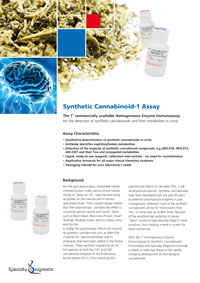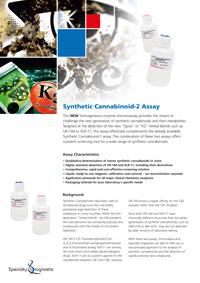Specialty Diagnostix offers a multi-pronged approach to the analysis of synthetic cannabinoids to counter the new Spice compounds rapidly emerging on the market.
The Synthetic Cannabinoids-1 assay has been the first commercially available homogeneous enzyme immunoassay for the detection of synthetic cannabinoids and their metabolites in urine.
With the new Synthetic Cannabinoids-2 assay, we provide the means to challenge the next generation of Spice and other herbal blends, such as UR-144 or XLR-11. This homogeneous enzyme immunoassay effectively complements the already available Synthetic Cannabinoids-1 assay.
The combination of these two assays provides a potent screening tool for a wide range of synthetic cannabinoids. Neither of the two kits requires any sample preparation. Both offer a high throughput and excellent sensitivity, specificity and efficiency, and present a broad cross-reactivity profile. Together, they enhance their individual screening capacities for optimal results.






